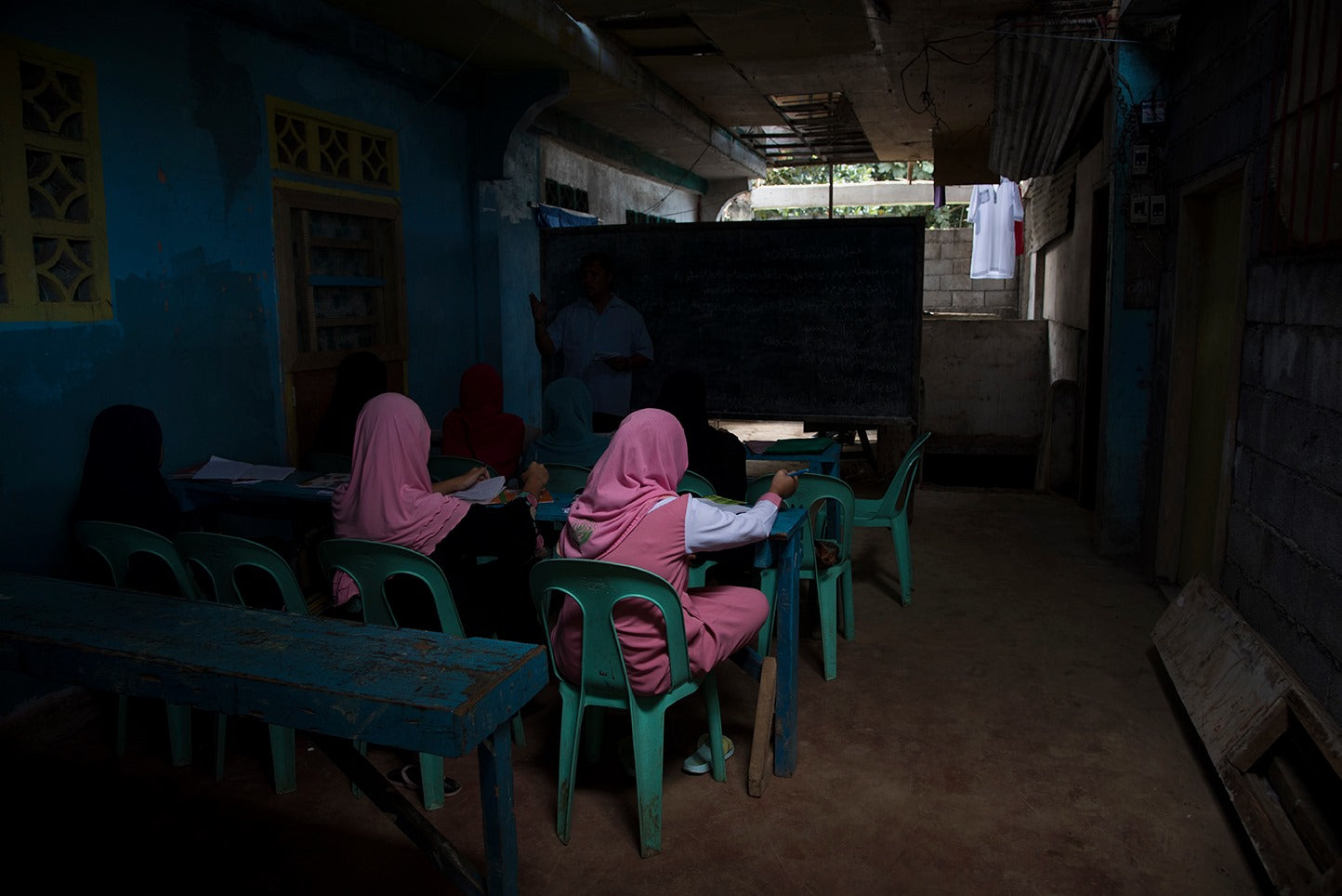The US withdrawal from Syria has led the media to start paying attention again to a subject they had all but abandoned: the terrorist group ISIS.
A few years ago, you couldn’t turn on the news without seeing the black flag of ISIS rising above a low-slung building in a far-off place. Then US domestic politics exploded, Russia and China stole all the column inches, and the pundits decided ISIS was yesterday’s news. With no large-scale terrorist attacks on Western targets in the headlines, people began to ignore them.

The black flag of the Islamic State raised over the Butig municipal hall, Lanao del Sur, Philippines in early 2017.
For those of us who served in the Global War on Terrorism, we knew it was only a matter of time before ISIS was back on our front pages. Because those of us who have been in combat know the limits of military force and we know all too well, that one drone strike here or one successful raid there doesn’t end a terrorist movement. Terrorists simply slink away, lick their wounds, and regroup. They have the one thing we don’t: the time to wait for US forces and their allies out until our public or our leaders decide they’ve had enough.
I’ve seen this firsthand. I was deployed to the Joint Special Operations Task Force—Philippines (JSOTF-P) in 2009—my fellow soldiers and I were tasked with helping the Armed Forces of the Philippines (AFP) track and neutralize terrorists, while building stability in communities. We were after a high-value targets like Isnilon Hapilon, who we never found. He took refuge in the hinterlands of the Philippines and in the communities there protected him. Ten years after my deployment, he reappeared as the head of the Islamic State in East Asia (ISEA). He had time, we did not.
Hapilon’s re-emergence on the scene drove me crazy. What had the men I served with died for if this guy could just go into the wilderness and stroll back later to ascend his throne? What had we all suffered for if a high-level terrorist leader could just decide to put his fight on hold for a while, until the US military pulled up stakes?
I’m not the only one who has experienced this frustration. Almost everyone I know who has worn a uniform has at least one moment during their service when they see the utter futility of fighting terrorists with conventional warfare. Sometimes it’s a terrorist leader you can’t kill. Sometimes it’s watching the guys you were shooting at shaking hands and snapping photos with politicians just a few months later. Sometimes it’s seeing local warlords get rich because of US “involvement” in a region. Most of the time, you laugh and move on—it’s just a macabre part of military life. The military makes you superb at doing pointless work and doing it with a smile.

But Hapilon’s comeback tour as a terrorist leader was different for me.
For one thing, it was personal: I hated that the guys I served in the Philippines with died in vain. For another, it was odd. Hapilon was leading tribes that despised each other. How could that be? How had these far-flung groups—none of which swore allegiance to a single ISIS caliphate—suddenly managed to unite around one guy who hadn’t been on the scene in a long time?
For our purposes, I’ll give you the short answer: while Hapilon was waiting us out, he tapped into a big group of frustrated young men, some of whom had been radicalized while studying in the Middle East and Indonesia. They came back ready to recruit, and the communities they recruited from were poor and vulnerable. Because the US and others weren’t paying attention anymore, Hapilon and his acolytes could teach radical Islamism in schools far from city centers. They could convince bored, out-of-work young men that they needed to join their cause. And they could promise pay and purpose to people who had little of both.
The Filipino military tried to fight him with some small successes. But he and his cohort just melted back into the jungles. I know this because I was there. I was leading an NGO that does work around the world in vulnerable communities. And because I was a glutton for punishment, I wanted to finish the business I had started in this region when I wore a uniform. This time, I came in civilian clothes, with a small group trying to figure out how to defeat Hapilon and end ISIS influence in the region.

The biggest lesson I’ve learned in my transition from the military to civilian aid and resiliency work is this: it’s very hard to talk to and understand people when you have a rifle in your hands. Most people who serve in the US military mean to do right by the communities they deploy to but we’re always behind the eight ball. People are so suspicious of the uniforms and the guns. It’s rare that you get to the actual root cause of anything and by the time you get close, your deployment is done and you’re going home.
Want to know what happens when you listen to communities? You learn things. For instance, I learned that the communities that Hapilson and ISEA had taken hold of didn’t want him there. They weren’t radical Islamists. They didn’t like their young men hanging out with his forces. They didn’t particularly agree with what was being taught in his schools. But they did like the money he doled out, and the young men in the area liked the fact that he gave them something to do and a message to rally around. Their farms had failed and the government didn’t make an effort to reach out to the far flung communities where ISIS had sought safe haven. They were young men without an identity or a future, and because they, like all young men, want to be viable mates one day, they styled themselves as terrorists. Better to tell a great story to a future mate—or at least, a better story than saying you were an out-of-work farmhand.

My organization does extensive survey work in these remote areas to understand problems at the root level, to better address them with our projects. We do a lot of numbers-crunching, and more importantly, we talk to huge groups of people and get qualitative information. We spoke to over 12,000 people in this region over the past few years, face-to-face, person-by-person, in their communities that often lack cellular connectivity. By the end, we had a pretty good plan of attack. If we could fix the livelihoods and governance issues in the community, bring in some high-quality rice, and get a teacher back so the boys could call themselves students, a lot of the appeal of ISEA would disappear. While Hapilon was killed a few months prior, his successor, Abu Dar, had taken up safe haven in Pagayawan, recruiting young men to his cause, thinking that like always, no one would pursue him into the safe haven and give his recruitment targets an alternative. He was incorrect.
It wasn’t easy. We had to scrape, borrow, beg and steal. We had some good partners in the Filipino military, the Moro Islamic Liberation Front, the US Civil-Military Support Element (CMSE) led by Angela Smith, and an NGO called the Spirit of America. Together, we got money, protection, rice and other necessary goods. Humanitarian assistance distributions are always tougher than they appear. You can’t just show up to a place and give aid away. No security? You’ll cause a riot or lose your own people. No beneficiary registration? You’ll give the aid out to the wrong people. No local government present? You could undermine the legitimacy of the groups that will be working in this community years after you’re gone.
But we knew all this and we planned ahead. We also didn’t just hand stuff out. We worked with the local leadership to build a cooperative to manage the various projects and govern the water use (now flowing because of new water pump provided by the CMSE through Spirit of America), and we brought pipes and reservoirs so they could store for the future. That had an important secondary benefit: the community was learning how to work together toward a common purpose. They were building strength and self-sufficiency. They were in charge—not us. Many of use had done water projects all over the world, but those wells had failed to impact the stability of the local community, often because it created another resource to fight over. This water project in Padas, Pagayawan, Philippines was different. It was a governance project, that just happened to supply water. And through that governance, the community learned to work together again.

Impl. Project local handing out humanitarian aid to families displaced by fighting with the Islamic State in Padas, Philippines.
These programs worked well. But they were successful because we had good data. Look, I get it: this is usually the point in the story when people roll their eyes. “Data” doesn’t make a great war cry or recruiting pitch. You’re not going to get people to sit up straighter in their seats by talking about surveys. But they ought to—because it’s the only viable, long-term way for the US and her allies to win the global war on terrorism. Absent better-informed decisions, we will always be playing a game of whack-a-mole with terrorist organizations—hitting them hard from time to time, only to have them pop back up whenever they please.
Additionally, technology gives us a leg up we’ve never had before. As I was transitioning out of the military, I did a two-year stint with a Silicon Valley tech company that focuses on data gathering. And it’s the tools and techniques I learned there that helped me figure out that you can talk to 12,000 people in [time] and then figure out exactly what they need. It’s because of technology that we could get good data and it’s because of good data that we could make an actual difference.
After just eight months of this work, ISEA’s influence disappeared from this community. The Philippine Army had killed Abu Dar but his group lived on, weakened, but still a threat and relocating to yet another far flung municipality. I’ve seen with my own eyes and hands how he and terrorists like him can be defeated. And the crux of the strategy isn’t bullets or bombs or better munitions—it’s getting as rigorous about how we collect information in these areas as we are about how we deploy US service-members to them. Data and the right projects can defeat ISIS and we need to make these efforts in the vulnerable parts of the world a priority before it’s too late.
Justin Richmond is the Executive Director of Impl. Project and spends most of his time traveling the world looking for people to assist in jousting windmills. He has been slightly more successful than his muse, Don Quixote.



Leave a comment
This site is protected by hCaptcha and the hCaptcha Privacy Policy and Terms of Service apply.